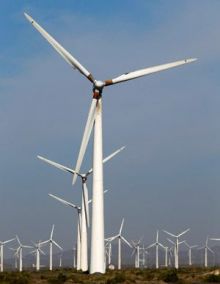The domestic market of alternative fuels will grow much more rapidly than previously expected due to the rapid rise of the Russian natural gas price. There are clear signs of this trend already, experts say.
According to the president of the Association of Alternative Fuels and Energy Market Participants of Ukraine (APEU) Vitalii Davii, the production of “green” electricity increased by 15.7 percent in the first six months of 2011 compared to the corresponding period of 2010 and reached 274.343 million kilowatt-hours. Out of this, small hydro power plants generated 191.961 million kilowatt-hours of electricity, wind power units produced 29.839 million kilowatt-hours, bioenergy plants generated 3.484 million kilowatt-hours, while solar energy plants’ output was 3.335 million kilowatt-hours. Davii predicts that growth rate of alternative power production will be 16-18 percent in the second half of the year due to the fast speed of constructing and launching of new facilities in Ukraine.
The solid biofuels market, which includes fuel briquettes and wood pellets and agricultural residues [biomass. – Ed.], is showing strong positive trend, too. In fact, its turnover increased by 36.4 percent to 451,600 tons, despite the fact that producers of solid biofuels from wood were facing a supply crisis from May through June this year due to the raw materials’ deficit and corresponding cost increase. The crisis forced about 80 percent of the producers to halt production in early August. Now the situation has improved, says Ivan Nadein, chairman of the Association of Alternative Fuel Producers. “Everyone looks at alternative energy sources as a real alternative. We are able to plan to increase the annual production of solid biofuels to nearly one million tons at present. This level may correspond to 10 percent of the European consumption and up to 20 percent of the European imports,” he clarifies.
Ukraine produces “green” motor fuel, too, with about 500 tons produced in the first half of the year.
Thus, the industry is experiencing an active recovery, Davii says. Though, according to him, the alternative energy share in the national energy balance is only 0.35 percent for now. However, it is expected to grow. In particular, APEU board member Serhii Apalkov predicts quadrupling of the solid biofuels production between this fall and the fall of 2012. The experts say the market of alternative fuel and energy as a whole may grow by 50 to 100 percent.
Increased production and consumption of non-conventional fuels are direct consequences of the natural gas price rise in Ukraine and European countries. Ukrainian solid biofuels prices grew by 5 to 7 percent annually in the recent years, but the prices are up 15 to 16 percent already this year, even despite the fact that the heating season has not started yet, Apalkov says. “So there is a competition between export and domestic orientations on the solid biofuels market now. Can the European consumer pay higher price and buy out the Ukrainian produce? In my opinion, the answer will be ‘no’, should the Russian natural gas price for Ukraine increase further as fast it does now,” he asserts.
According to the experts, alternative energy industries look very promising in Ukraine. However, every specific industry has its own constraints for development. Thus, for example, the solid biofuels production is hampered by a need to modernize the plants. According to Apalkov, the only way to make a company profitable in this industry is to increase its production capacity three to four times [from 120-140 to 350-400 tons per month. – Author.] “Today, there are isolated instances of use of the German technology, but there are too few of them, and they do not determine the state of the industry,” he says. “What we really need is organized, sufficiently rapid technological upgrading of the industry to increase output and improve quality of production.”
The experts add that the Ukrainian market of alternative fuels and energy will develop along the global market’s lines. However, only enterprises or wealthy Ukrainians will afford installing mechanisms that run on these technologies. To build a small wind turbine at home, one would need about 10 to 11 thousand dollars, a large wind farm will require 0.5 to 1.5 million euros in capital costs, a small solar power plant on the roof will cost 20 thousand euros, while a large one will take 0.5 to 2.5 million euros. Solid biomass-fueled boilers are more affordable for Ukrainians, costing on average 1,500-2,500 euros. Payback period is 7 to 8 years.
Meanwhile, international analysts are predicting steady growth in the “green” energy sector. The attractiveness of such projects may increase against the backdrop of the acute economic crisis in the United States and the European Union, according to the study of the industry that was prepared by the Renewable Energy Center Fuel Alternative (REC Fuel Alternative). The REC Fuel Alternative’s analysts believe that solar, wind and hydro power projects are the least risky ones in terms of economy, for they are not linked to volatile commodity markets. “The implementation of renewable energy projects requires, in fact, only the capital investments in the creation of generation capacity. Later on, the only important parameter of the project is electricity tariff. The power plants’ main resources are sun, wind and water, which are free and do not depend on market fluctuations. This business model has very high levels of liquidity nowadays,” the report says.
To illustrate the increasing investor attention to the renewable energy industry, the REC Fuel Alternative’s experts note the results of the latest (at the time of their report’s preparation) trading session at the London Stock Exchange on August 5, which ended with the overwhelming majority of companies falling in price, while the food and renewable energy companies’ stocks rose. The clean technology companies were quoted on average 0.1 to 3 percent higher. According to the REC Fuel Alternative’s, the amount of investment in European and Ukrainian renewable energy industry may increase strongly in the next year.







